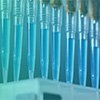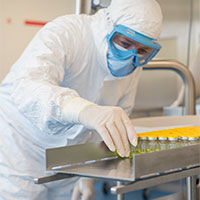Controlled Environment and Cleanroom SolutionsControlled Environment and Cleanroom SolutionsControlled Environment WorkflowsWhat is a Controlled Environment?A controlled environment is one in which multiple environmental factors are monitored and controlled using controlled environment equipment. The controlled parameters typically include:
What is a Cleanroom?Cleanrooms are controlled environments that limit the number of pollutants, or contamination, to a specified number of particles (by size) per cubic foot or cubic meter. Cleanrooms are tested regularly to ensure standards are met, and systems are in place to control the environment by limiting dust, chemical vapors, airborne microbes, and aerosol particles. Cleanrooms are used by manufacturing companies when a high level of sterility is necessary to avoid adversely affecting the product being manufactured. Cleanroom solutions vary based on the manufacturer’s needs and are used in a variety of industries, including:
What is a Cleanroom?Cleanrooms are controlled environments that limit the number of pollutants, or contamination, to a specified number of particles (by size) per cubic foot or cubic meter. Cleanrooms are tested regularly to ensure standards are met, and systems are in place to control the environment by limiting dust, chemical vapors, airborne microbes, and aerosol particles. Cleanrooms are used by manufacturing companies when a high level of sterility is necessary to avoid adversely affecting the product being manufactured. Cleanroom solutions vary based on the manufacturer’s needs and are used in a variety of industries, including: Controlled environment equipment is used to reduce particulate contamination and ensure the humidity, temperature, air pressure, and other environmental factors are kept within the appropriate parameters.
What Are the Standards for a Cleanroom?The standards for a cleanroom are based on the number of particles measured in one cubic foot or one cubic meter of air. Cleanrooms are classified using either the Federal Standard 209E of the USA or ISO 14644-1 standard. Federal Standard 209E classifies cleanrooms with numbers like “class 1,000” or “class 10,000,” and classifications are based on the number of particles of size 0.5 μm or larger allowed in one cubic foot of air. ISO 14644-1 standard classifies cleanrooms with smaller numbers like “3” and classifications are based on a decimal logarithm of the number of particles 0.1 μm or larger allowed in one cubic meter of air.
What Type of Equipment and Supplies Are Necessary to Make Sure a Cleanroom Meets Necessary Standards?The type of controlled environment lab equipment and supplies necessary to make sure a cleanroom meets necessary standards includes:
|

|
Processing your request... |


































